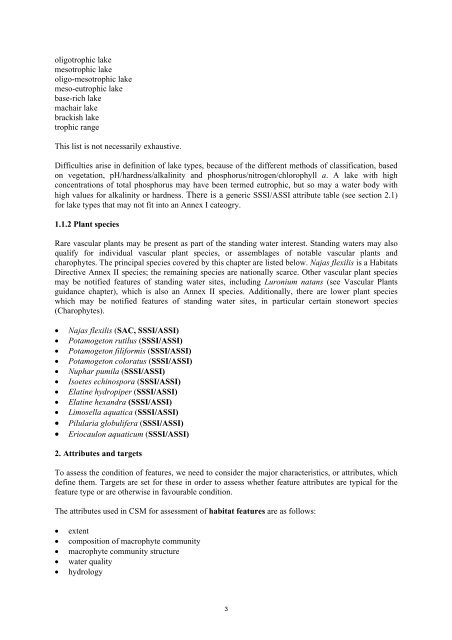Common Standards Monitoring Guidance for ... - JNCC - Defra
Common Standards Monitoring Guidance for ... - JNCC - Defra
Common Standards Monitoring Guidance for ... - JNCC - Defra
Create successful ePaper yourself
Turn your PDF publications into a flip-book with our unique Google optimized e-Paper software.
oligotrophic lake<br />
mesotrophic lake<br />
oligo-mesotrophic lake<br />
meso-eutrophic lake<br />
base-rich lake<br />
machair lake<br />
brackish lake<br />
trophic range<br />
This list is not necessarily exhaustive.<br />
Difficulties arise in definition of lake types, because of the different methods of classification, based<br />
on vegetation, pH/hardness/alkalinity and phosphorus/nitrogen/chlorophyll a. A lake with high<br />
concentrations of total phosphorus may have been termed eutrophic, but so may a water body with<br />
high values <strong>for</strong> alkalinity or hardness. There is a generic SSSI/ASSI attribute table (see section 2.1)<br />
<strong>for</strong> lake types that may not fit into an Annex I cateogry.<br />
1.1.2 Plant species<br />
Rare vascular plants may be present as part of the standing water interest. Standing waters may also<br />
qualify <strong>for</strong> individual vascular plant species, or assemblages of notable vascular plants and<br />
charophytes. The principal species covered by this chapter are listed below. Najas flexilis is a Habitats<br />
Directive Annex II species; the remaining species are nationally scarce. Other vascular plant species<br />
may be notified features of standing water sites, including Luronium natans (see Vascular Plants<br />
guidance chapter), which is also an Annex II species. Additionally, there are lower plant species<br />
which may be notified features of standing water sites, in particular certain stonewort species<br />
(Charophytes).<br />
• Najas flexilis (SAC, SSSI/ASSI)<br />
• Potamogeton rutilus (SSSI/ASSI)<br />
• Potamogeton fili<strong>for</strong>mis (SSSI/ASSI)<br />
• Potamogeton coloratus (SSSI/ASSI)<br />
• Nuphar pumila (SSSI/ASSI)<br />
• Isoetes echinospora (SSSI/ASSI)<br />
• Elatine hydropiper (SSSI/ASSI)<br />
• Elatine hexandra (SSSI/ASSI)<br />
• Limosella aquatica (SSSI/ASSI)<br />
• Pilularia globulifera (SSSI/ASSI)<br />
• Eriocaulon aquaticum (SSSI/ASSI)<br />
2. Attributes and targets<br />
To assess the condition of features, we need to consider the major characteristics, or attributes, which<br />
define them. Targets are set <strong>for</strong> these in order to assess whether feature attributes are typical <strong>for</strong> the<br />
feature type or are otherwise in favourable condition.<br />
The attributes used in CSM <strong>for</strong> assessment of habitat features are as follows:<br />
• extent<br />
• composition of macrophyte community<br />
• macrophyte community structure<br />
• water quality<br />
• hydrology<br />
3
















